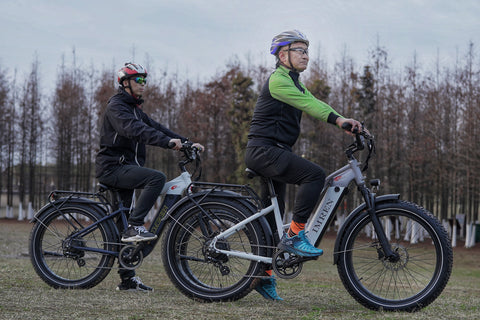
Intro to Electric Bikes (E-Bikes)

When many of us were first learning to ride, we might have been given a gentle push to jump-start our momentum. In many ways, that’s what the motor on an electric bike can do for you today, except that the boost it provides sustains for as long as you continue to pedal.
This electric bikes (e-bikes) overview covers these key topics:
- Why consider an e-bike? Pros and cons.
- Where can you ride e-bikes (and where can’t you)?
- How to ride an e-bike—the basics and safety tips
- How long do e-bike batteries last?—and why it’s hard to predict
- Tips for caring for your e-bike—and its battery
If you’ve already decided to get an e-bike, you can read How to Choose an Electric Bicycle to learn a few things to think about before you shop.
Why Consider an E-bike?

It’s not true (yet) that everyone is riding an e-bike these days, but sales have soared in recent years.
Interestingly, as many as half the e-bike buyers of today are people who didn’t consider themselves a cyclist before their purchase. The motivations of e-cyclists vary, but the following are oft-cited reasons you might want to consider an e-bike:
- To keep up with a friend or partner who is an avid rider.
- You think riding a bike is fun and healthy, but don’t want to be limited by hilly routes, long distances or the logistics of arriving sweaty at your destination.
- Speaking of fun—new e-bike riders tell us all the time that riding one is simply a blast to do.
- You want to commute to work, and you’re motivated to reduce carbon dioxide emissions, get exercise and have more fun along the way.
- You want an alternative to jumping in your car for around-town errands.
The common denominator here is that an e-bike simply opens up more possibilities for people: new parents who are hauling young kids in a trailer on up to older or injured riders who aren’t as strong as they were in their youth. Commuters can keep up with the flow of traffic. Mountain bikers no longer have to rule out routes with steep hill climbs. And shoppers can haul more bags of groceries home from the store.
It’s worth noting that e-bikes do not rob you of a good workout. It’s certainly true that a given ride might be easier, but e-bike riders are also going farther, pedaling with a faster cadence, climbing steeper hills and riding more often than they ever did on a conventional bike. It’s also worth noting that (most) e-bikes are called “pedal-assist” bikes because the motor only works when you’re moving the pedals—that means that your body is still doing a significant amount of work.
Cons of e-bikes compared with traditional bikes:
- E-bikes cost more than conventional bikes—low-end prices are north of $1,500. (If your e-bike replaces car commutes and errands, though, then you can recoup that investment.)
- Greater weight means that hefting and transporting (car racking) an e-bike can also be challenging.
Where Can You Ride E-Bikes?

The universal answer to where one can ride any type of e-bike is “on the street.” After that, though, things are less clear because laws and regulations are still evolving.
The other key thing to keep in mind about e-bike access is you need to research local rules and regulations for your class of e-bike for the places you plan to ride it.
Understanding e-bike access rules starts with an understanding of e-bike classes:
- Class 1: The motor kicks in only while you’re actively pedaling, and the motor assist stops when you reach 20 mph.
- Class 2: Has a pedal-assist mode up to 20 mph; it also offers a throttle-only mode. (No other class of e-bike offers this mode.)
- Class 3: Works like Class 1 (pedal assist only), but the motor won’t stop assisting until you reach 28 mph.
Class 1 e-bikes are the most universally accepted. That’s one reason why they are also the most popular choice. But class 1 bikes aren’t allowed on all bike paths, especially ones where the speed limit is 15 mph. Some mountain-bike trail systems also forbid all classes of e-bikes, though access is generally beginning to open up for class 1 e-bikes.
Class 2 e-bikes are banned in many places. Any mountain bike trail where motor-powered vehicles are prohibited also won’t allow class 2 e-bikes. City streets and off-road vehicle areas are your only sure bet for class 2 access.
Class 3 e-bikes are primarily allowed on city streets. The greater speed their motor assist provides, though, can be an advantage when you want to keep up with vehicle traffic when you commute or run errands on your e-bike.
People for Bikes, an advocacy group for cycling publishes a state-by-state e-bike guide to help you sort through e-bike regulations around the country. (Check this list, too, for licensing, registration and age regulations in each state.)
How to Ride an Electric Bike

While it does differ from riding a regular bike, most e-bike newbies get the hang of it quickly. Typically, it only takes one test ride for the body’s muscle memory to adapt to the feel of a pedal-assist machine.
Keep the following tips in mind when you first start riding an e-bike:
- Brake earlier because e-bikes are heavier (and faster). Pedal-assist power overcomes the sluggishness that a heavier bike might have, but a fast-moving weighty mass also requires an attentive brake hand. E-bikes come with robust brake systems to help, but you still have to be on top of your riding game.
- Ride with a faster cadence. An e-bike is most efficient when pedaled at a faster cadence than is typically used on a regular bike, especially when climbing hills. It’s not that you can’t have a lower cadence, it’s just that your e-bike rides more smoothly and gets better battery life if you spin the pedals faster. So get used to using lower gears.
- Ride in low-assist modes as much as possible. Motor settings range from “eco” to “turbo” (terms vary), with one or two in between. Mode choice has a direct effect on battery life—riding range—so the more you ride in eco mode, the better. Save turbo for when you truly need it. If you feel eco isn’t helping much, try riding with the motor switched off—eco will feel zippy after that. Less assist from the motor also means you get a better workout.
How Long Do E-bike Batteries Last?

Stated ranges for e-bikes tend to be very broad. That’s because so many variables affect riding range. Motor size matters, of course: At a given battery capacity, a more powerful motor means more performance and less range. But where and how you ride also play a role.
The following factors on your ride all affect battery life and riding range:
- More time in eco mode extends battery life. Turbo mode reduces it.
- Riding steeper hills reduces range. Hills often require higher modes.
- Greater overall weight reduces range. (Bike + rider + cargo weight combined.)
- Spinning the pedals faster can extend battery life. Slower spinning reduces it.
- Cold temperatures reduce battery life. Storing and charging it indoors helps, but range will still be less when riding in winter temps.
Anything that makes it more challenging to ride a standard bike can have an effect on battery life. That includes details like proper tire inflation.
Tips for Caring for an E-Bike

The charging setup differs slightly from e-bike to e-bike. Many let you remove the battery to charge it indoors, for example. If you commute with your bike, then it might make sense to invest in a second charger to keep at work. Note, too, that cold temperatures can sap battery power, so storing the battery indoors during the winter is wise.
Other than the battery, basic maintenance on an e-bike is pretty similar to that on a conventional bike. So basic bike-maintenance tips apply:
- Always do a preride inspection, checking the ABCs (Air pressure, Chain and Brakes).
- Take good care of the chain
- Take good care of the brakes


